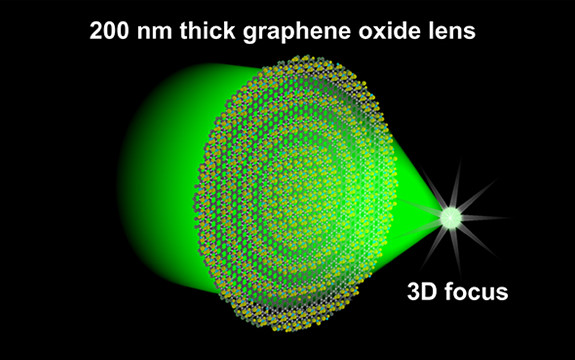A flat optical lens just a billionth of a meter thick will let us see living creatures as small as a single bacterium better than ever before. The new lens, developed by researchers at Swinburne University of Technology, promises to revolutionize much of the technology around us.
Driven by developments in photonic chips and nano-optics, the global race to create a practical ultrathin lens that breaks the diffraction limit — enabling a focus less than half the wavelength of light — had been gathering pace since the turn of the millennium.
The new lens, developed by researchers at Swinburne University of Technology, promises to revolutionize much of the technology around us.
The design of the GO lens. (a) Conceptual design and laser fabrication of the GO ultrathin lens. (b) Amplitude and phase modulations provided by the transmission and refractive index difference, respectively, between the GO and rGO zones.
The principle had recently been demonstrated using metal-based materials — predominantly gold — but these were too inefficient and too costly to mass-produce. The development of a practical prototype was hampered by the lack of a suitable material.
Just over two years ago, PhD student at Swinburne’s Centre for Micro-Photonics, Xiaorui Zheng, tried fashioning a lens using graphene oxide — a variation of the super-strong, atom-thick carbon material, graphene. The team, led by Associate Professor Baohua Jia, developed a three-dimensional printer that could quickly and cheaply produce the lens using a sprayable graphene oxide solution. Lasers were used to precisely pattern the surface, creating three concentric rings of reduced graphene oxide, which enabled its extraordinary focus.
The result is a very strong and flexible flat optical lens that is 300 times thinner than a sheet of paper and weighs a microgram — next to nothing. At the same time, it has a precise and adjustable three-dimensional focus that allows a detailed view of objects as small as 200 nanometres long at wavelengths ranging from visible to near infrared.
It’s early days, but the new technology has the potential to reduce the size and weight of mobile phones in which cameras are currently dependent on thick and heavy lenses. If that happens, it will mean that new phone cameras could focus light near the infrared spectrum, allowing thermo-imaging and possible remote medical diagnosis.
The recent breakthroughs in nanophotonics have led to the design and demonstration of a number of ultrathin flat lens concepts such as metamaterials, metasurfaces or super-oscillations, which have achieved subwavelength resolution in two dimensions. In particular, all-dielectric metasurface lenses show promising results in reducing the Ohmic losses. However, the narrow operational bandwidth, the complex design and time-consuming multi-step manufacturing process have greatly limited their real-life applications especially when large-scale production and micro-devices integration are required. Therefore, it is highly desirable to develop ultrathin flat lenses with 3D subwavelength focusing capability, a large operational bandwidth, and a practically useful focusing efficiency (over 20%) with a simple and low-cost fabrication method.
Here, we propose a new ultrathin flat lens concept that is able to effectively manipulate the phase and amplitude of an incident beam simultaneously. We report on a 200-nm-thick graphene oxide (GO) flat lens with 3D subwavelength focusing that is able to tightly focus broadband light from the visible to near infrared (VIS–NIR; ~1,100 nm bandwidth) with an averaged absolute focusing efficiency of over 32% over the entire band.
Abstract
Nanometric flat lenses with three-dimensional subwavelength focusing are indispensable in miniaturized optical systems. However, they are fundamentally challenging to achieve because of the difficulties in accurately controlling the optical wavefront by a film with nanometric thickness. Based on the unique and giant refractive index and absorption modulations of the sprayable graphene oxide thin film during its laser reduction process, we demonstrate a graphene oxide ultrathin (~200 nm) flat lens that shows far-field three-dimensional subwavelength focusing (λ3/5) with an absolute focusing efficiency of over 32% for a broad wavelength range from 400 to 1,500 nm. Our flexible graphene oxide lenses are mechanically robust and maintain excellent focusing properties under high stress. The simple and scalable fabrication approach enables wide potential applications in on-chip nanophotonics. The wavefront shaping concept opens up new avenues for easily accessible, highly precise and efficient optical beam manipulations with a flexible and integratable planar graphene oxide ultrathin film.
SOURCES – Nature Communications, Swinburne University of Technology

Brian Wang is a Futurist Thought Leader and a popular Science blogger with 1 million readers per month. His blog Nextbigfuture.com is ranked #1 Science News Blog. It covers many disruptive technology and trends including Space, Robotics, Artificial Intelligence, Medicine, Anti-aging Biotechnology, and Nanotechnology.
Known for identifying cutting edge technologies, he is currently a Co-Founder of a startup and fundraiser for high potential early-stage companies. He is the Head of Research for Allocations for deep technology investments and an Angel Investor at Space Angels.
A frequent speaker at corporations, he has been a TEDx speaker, a Singularity University speaker and guest at numerous interviews for radio and podcasts. He is open to public speaking and advising engagements.



